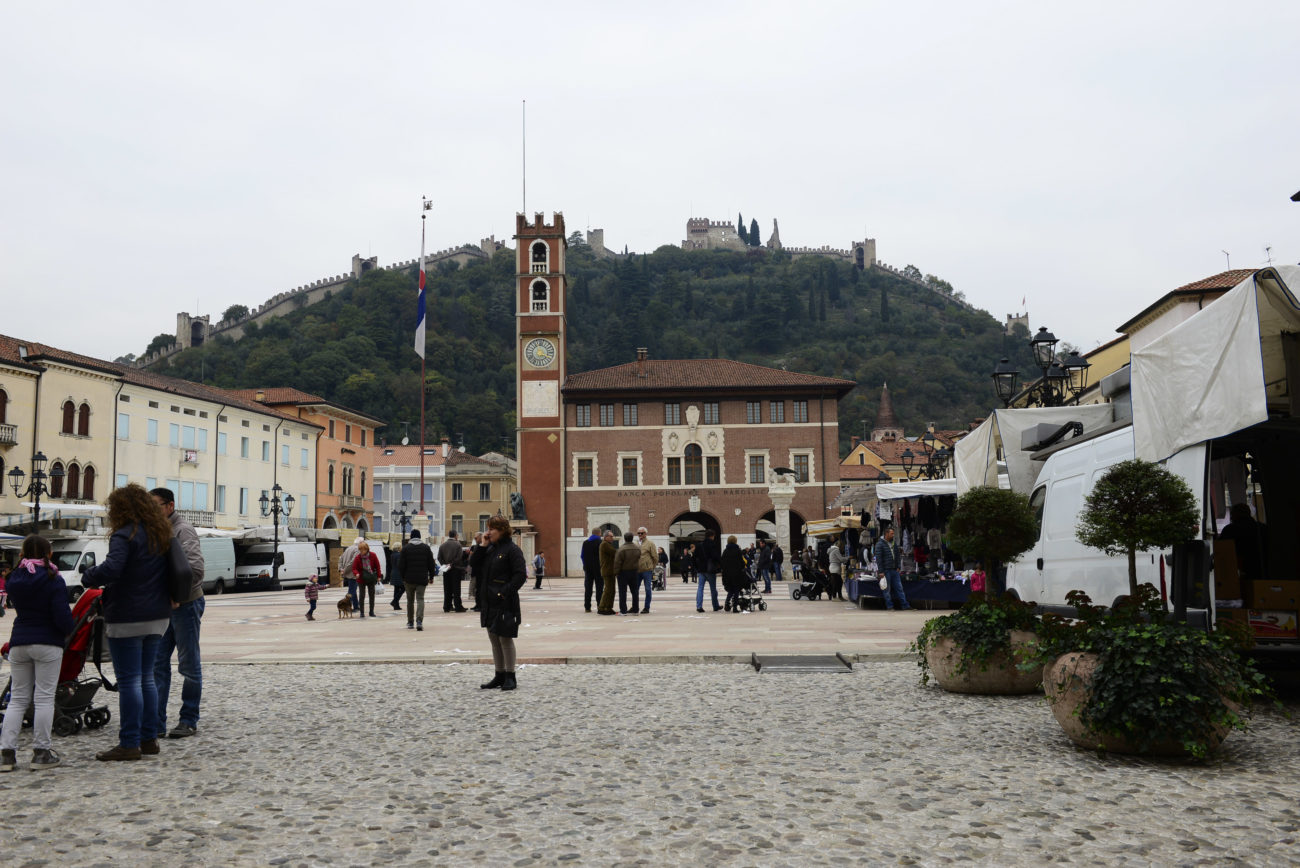Architecture of spectacle: The Partita a Scacchi in Marostica
Medina Lasansky writes about the impact of a fabricated festival on the small Venetian town of Marostica.
The Deborah J. Norden Fund, a program of The Architectural League of New York, was established in 1995 in memory of architect and arts administrator Deborah Norden. Each year, the competition awards up to $5,000 in travel grants to students and recent graduates in the fields of architecture, architectural history, and urban studies.
Medina Lasansky received a 1996 award.
In September every other year, the town of Marostica, Italy hosts a pseudo-medieval festival called the Partita a Scacchi – a chess game played with living figures. In 1996, I traveled to Marostica to study the impact of the festival on the built environment of this small Venetian town.
Introduced in 1954 as part of a broad postwar reconstruction program, the Partita helped to reestablish Marostica’s civic identity after World War II. Bringing prestige and income to the town through a series of urban renewal activities, the festival has made Marostica an exemplar for preservation, tourism and local industry in the Veneto region. With a new “heritage” self-consciousness, Marostica preserved existing monuments, created new ones, and reinvigorated her public space through an invented tradition.
Unlike Italy’s many other festival traditions, Marostica’s Partita is an ex-novo creation that seems medieval. Carefully designed to draw upon common stereotypes of medieval and Renaissance art, architecture, and literature, the town created an event that is so compelling that the audience never questions its authenticity.
Oddly, until now, the unusual character of this event has remained unstudied. Even scholars have been seduced by its seemingly authentic nature.
Prior to the invention of the Partita in 1954, Marostica was near ruin. Destruction caused by Allied troops during the war and by German troops during their retreat had left its piazza in bad shape and the town seriously damaged. In the decade following the war, industrial growth threatened Marostica’s built environment as peacetime industries began to encroach upon what remained of the historic center. For the visitor to Marostica in the early 1950s, there was little to do and less to see. There was no real tourist office, no hotels and only a few restaurants, no souvenir shops, no museum, and the town’s great attraction, the ruins of the Upper Castle, was inaccessible to tourists.
During this period, the town formed a tourist office called the Pro-Marostica, and began to rebuild along medieval lines. In 1953, the town council began reconstruction. With government monies awarded for repair of damages inflicted by foreign troops, Marostica resurfaced its piazza, laying down a twenty square meter marble chessboard to serve as a platform for the Partita. With the support of the Venice soprintendenza, the Ufficio del Genio Civilein Verona, and the provincial tourism office, Marostica restored its city walls and castle.
The Pro-Marostica developed a “medieval” story in which two young noblemen fall in love with the daughter of the local podestà. Since dueling was forbidden in the Venetian republic, the festival organizers decided that the suitors would play a game of chess for the girl’s hand in marriage. Unlike the Palio in Siena, the Calcio in Florence, and the Giostra in Arezzo, each of which is a true contest between neighborhoods, the Partita is a narrative recounting a contest between two individuals. The event was designed to involve the entire town as a single corporate body, brought to witness the contest that would determine the future of its favorite daughter.

The city center of Marostica, Italy is inlaid with a giant chessboard where a living chess event is played every other year. The city also hosts an annual spring cherry festival. (U.S. Air Force photo by Staff Sgt. Krystal Ardrey/Released)
Since the inception of the festival in 1954, Marostica has held the Partita every other September. Each time, buildings are decorated with floral festoons and banners, and the flags of the contrade fly throughout the town. Set against the backdrop of the restored fourteenth-century Lower Castle and Palazzo Doglione, five hundred characters in period costume entertain the audience for over two hours as they reenact the tale of courtly love. A character identified as the historian recounts the story in prose and verse, in Venetian dialect. Characters dressed as black and white pawns, rooks, knights, bishops, kings, and queens emerge from the castle to take their places on the marble chessboard. The podestà’s daughter, accompanied by her ladies-in-waiting and a group of noblemen, position themselves on one side. The master of the game and his knights on horseback stand on another, and the infantry fall into place opposite them. Ambassadors from neighboring towns sit at the foot of the board, and the contingents accompanying the two dueling gentlemen stand nearby.
The story in Marostica is fictitious. There was no such podestà, no daughter, and no suitors. The authors of this fiction made a conscious attempt to place the story within a believable historical context, playing upon the popular conceptions of the period. By drawing upon and reinforcing stereotypes of the chivalric Middle Ages, the pro-Marostica made the Partita appear authentic.
By laying claim to the city’s medieval past, the Partita mobilized Marostica. The theatrical setting of the scaligera castle and the magical quality of the festival are, as one Pro-Marostica pamphlet claims, proof that there is “an intense sense of nostalgia . . . in Marostica, a town that has been returned to its original form, to the world of fables and romance, history and poetry.”
As the curator of this heritage, the Pro-Marostica courts the press. The revival of this fantasy world has brought prestige to an otherwise obscure small town, making the festival a heritage commodity and spawning a lucrative tourist industry. Today, over a hundred thousand tourists – Italians as well as foreigners – visit each year, and the city is now complete with all the services, physical products, and experiences typical of tourist destinations. If history was domesticated in the 1950s, it was commodified by the 1980s.
Unlike some tourist destinations, though, Marostica has maintained control of its tourist culture. The Pro-Marostica designed and organized the Partita, manipulated and modernized it as necessary, orchestrated reconstruction efforts, supported the burgeoning industry of support services, and resuscitated local history. The final product, what Christine Boyer might refer to as the “city of collective memory,” depends on the collaboration of local individuals – designers, actors, advertisers, corporate sponsors, and hoteliers. The level of local energy devoted to this event demonstrates that Marostica’s culture is anything but meaningless.
In the case of Marostica, the development of tourism created community and safeguarded local culture. Because of this distinctively local quality, the town maintains a strong sense of culture difference compared to other Italian, and even European, towns and cities. The spectacle – the event and the architecture – signifies differently for the creators, the performers, and the audience. For the creators, it has placed Marostica on the map. For the performers, it is a weeklong celebration of civic identity that resonates throughout the year. And for the audience, it is a well-designed entertainment experience that celebrates the Middle Ages.
As many new studies have demonstrated, tourism is an integral feature of modern urban management. The tourist visits a city for a distinctive experience of urban spectacle: architecture and events that celebrate history. This exploitation of history as a resource for tourism is not new. During the early Christian period, pilgrims traveled to Rome, where powerful associations of people and events with specific sites shaped the built environment. Some spaces and monuments were preserved, while others were reorganized to facilitate viewing.
Recent scholarship has taken new and interesting tracks in discussing the city and what scholars vaguely describe as “memory.” Christine Boyer has noted that the architectural residues of earlier times have become important sites of pleasure within the city, serving either to “reawaken a forgotten memory” or to enable the viewer to relive a new past through “invented traditions and imaginary narrations.” Dolores Hayden considers the urban landscape a storehouse for collective urban memories and an important device in nurturing civic identity. By inventing a public memory and embedding it into its built environment, Marostica has created a pleasure site that carefully feeds the popular imagination of the past.
Myths have long been used to sell places, but in the case of Marostica, fabricated history completely transformed the city. The town is quite conscious of the extent to which its medieval past is integral to its contemporary identity, and city historic preservation projects continue to sustain the physical environment upon which this memory depends. The permanent site, the ephemeral event, and the visitor are inextricably and permanently linked.
Like many towns in modern Italy, Marostica seeks refuge in the “medieval.” A nostalgic version of the glorious period of civic independence, virile chivalric leadership, and communal society ordered by confraternities, guilds, and distinctive neighborhood and familial groups comprise a vision that is invoked particularly during periods of political transition and economic change, allowing towns to bolster their civic identities. In Marostica, a search for a usable past led to a viable position in postwar capitalism.
In the Partita, the audience is “courted” and “mated” in a scenario of commercial and civic seduction, as commerce becomes culture and the tradition of a fictive and ephemeral event assumes permanent form. Noblemen on horses, guild groups, representatives of neighborhood factions, ladies-in-waiting, and damsels in distress—all come out of the woodwork to create a sense of community and common genealogy that is predicated upon a romanticized view of the past.
The profit generated in Marostica is less immediate monetary gain and more stable and nuanced culture: increased civic recognition, a heightened sense of local and national identity, and a valuable tourist industry. The town has established a sense of civic identity by preserving its existing monuments, creating new ones, and invigorating its public space through an invented tradition, the reinterpretation of the courtly game of chess. The experience of the event has become inextricably linked to the sense of place.
Biographies
traveled to Marostica, Italy in 1996. Since then, she has continued her research on politics, popular culture and the built environment, and published the book The Renaissance Perfected: Architecture, Spectacle and Tourism in Fascist Italy (Penn State University Press, 2004). Now, she teaches urban development and history of architecture at Cornell University, where she is an Associate Professor of Architecture.
Explore
March 9, 2017
Emerging Voices lectures: Duvall Decker Architects & Leong Leong
The second evening of the annual Emerging Voices lecture series features Roy Decker and Anne Marie Duvall Decker of Duvall Decker Architects; and Chris Leong and Dominic Leong of Leong Leong.
Craig Ellwood
October 22, 1987 | Part of the lecture series Three Modern Architects | Reissued as part of Mid-Century Masters, a digital archive series.
Interview: Williamson Chong Architects
Donald Chong, Betsy Williamson, and Shane Williamson marry traditional materials and construction methods with emerging technologies.



